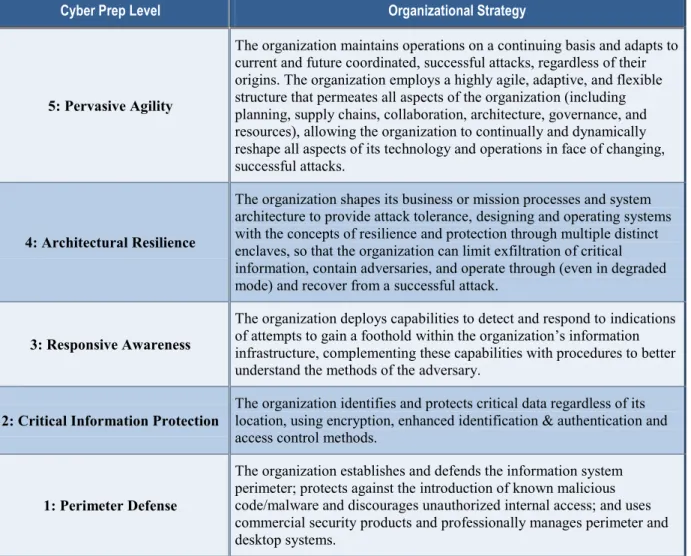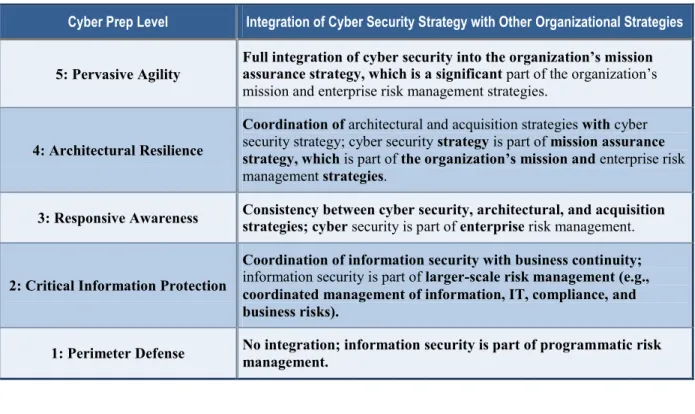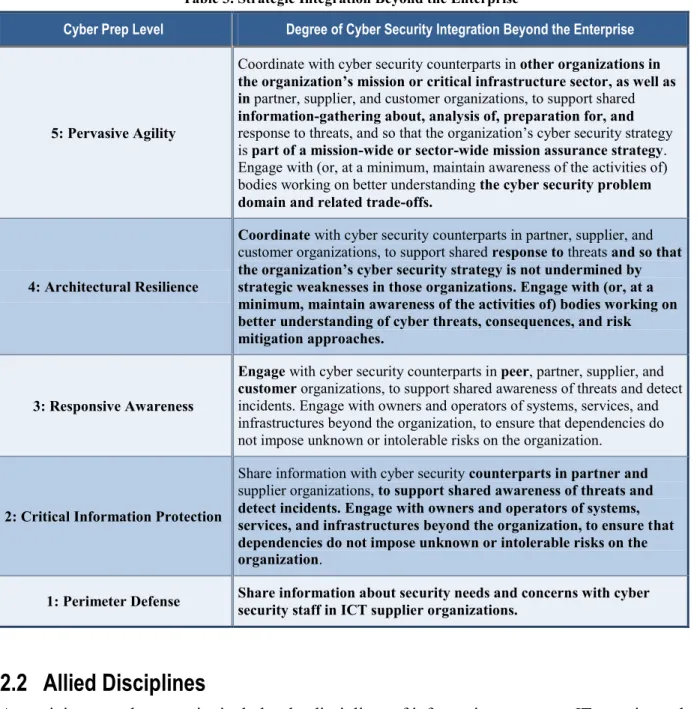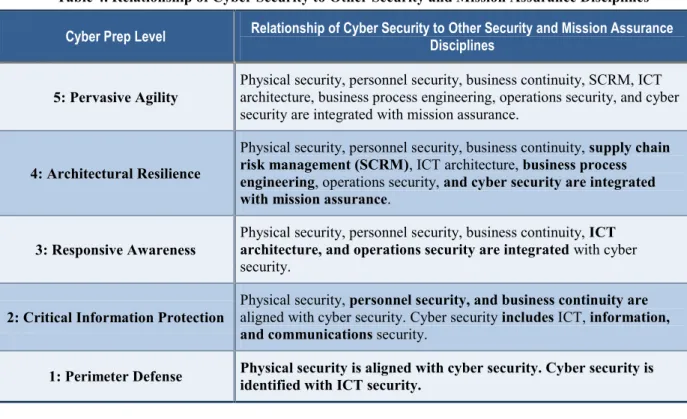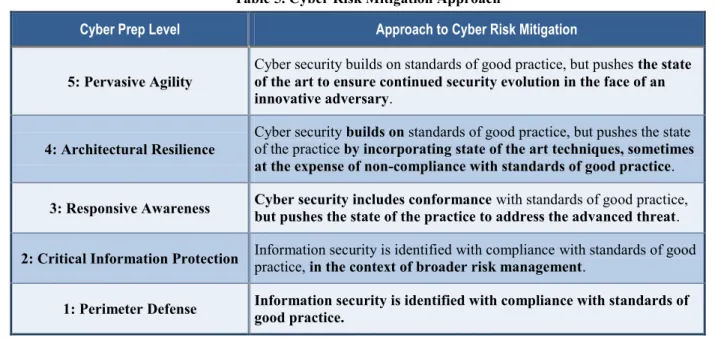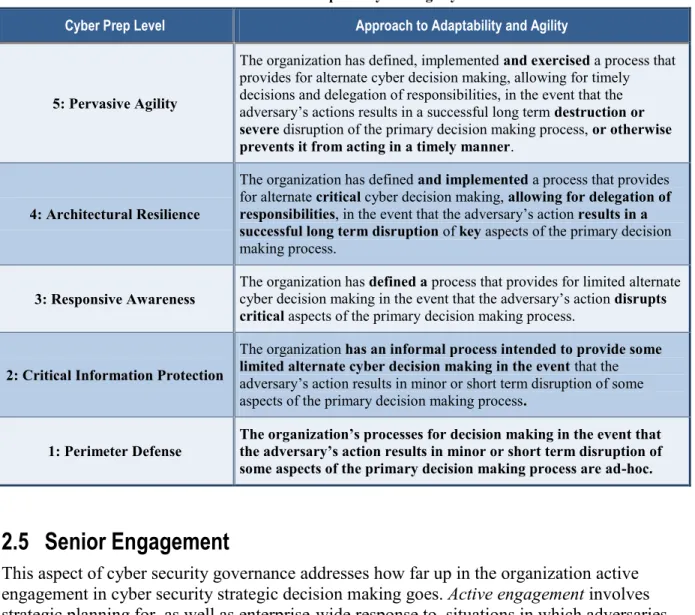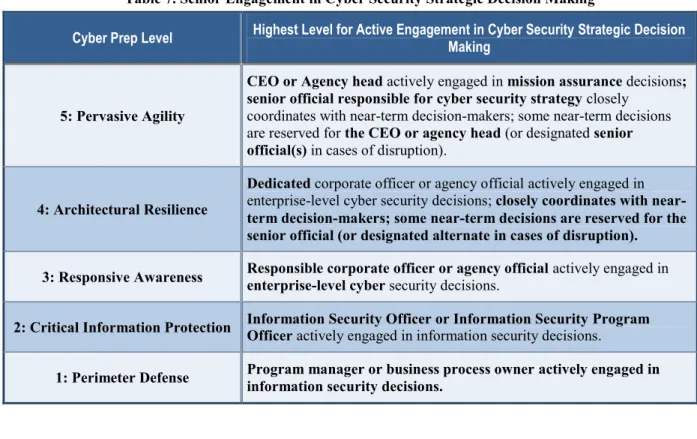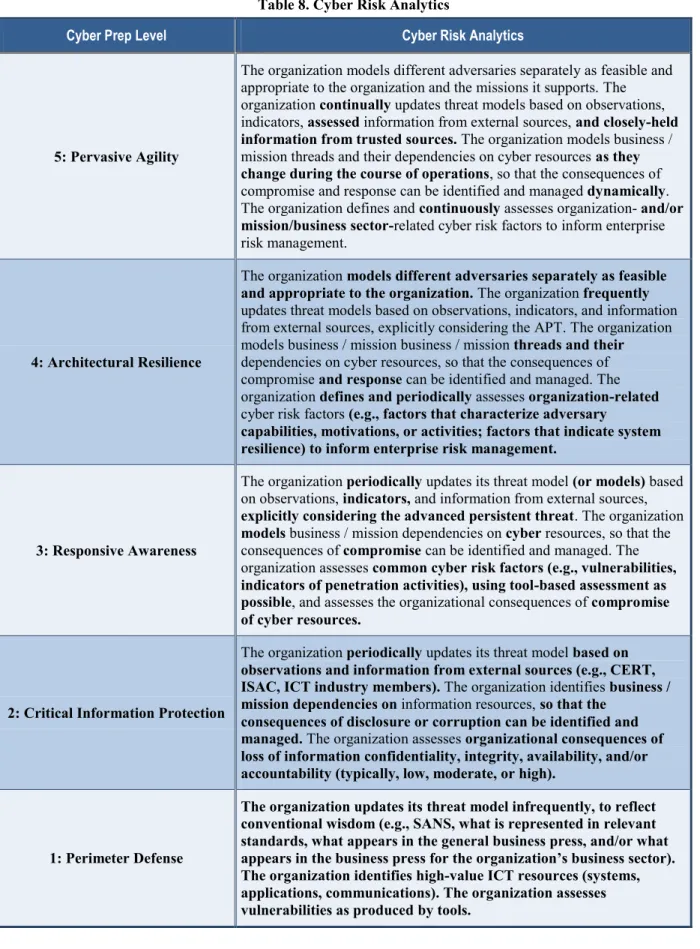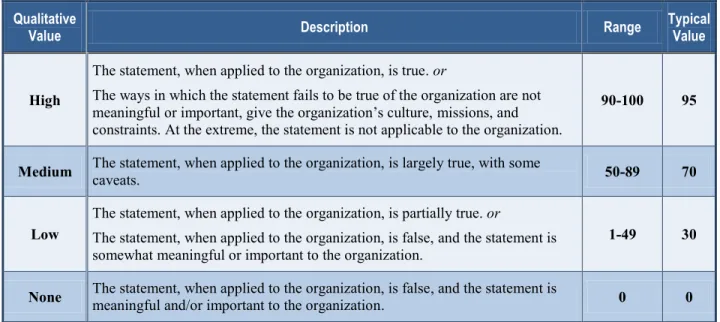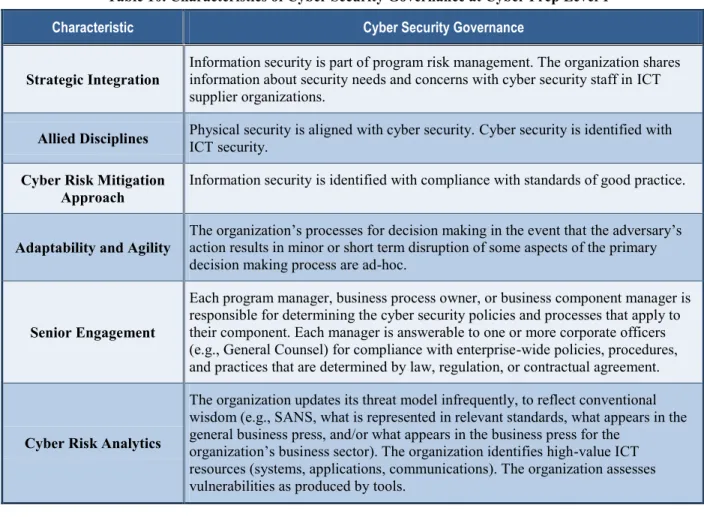Cyber Security Governance
A Component of MITRE's Cyber Prep
Methodology
Deb Bodeau, Steve Boyle, Jenn Fabius-Greene,
Rich Graubart
September 2010
M T R 1 0 0 3 0 8 M I T R E T E C H N I C A L R E P O R T Sponsor: Dept. No.: G020 Contract No.:Project No.: 01CCG005-AD The views, opinions and/or findings contained in this report are those of The MITRE Corporation and should not be construed as an official government position, policy, or decision, unless designated by other documentation.
©2010 The MITRE Corporation. All Rights Reserved.
Abstract
Cyber Prep is a conceptual framework, together with a practical methodology, which an
organization uses to define and implement its strategy for addressing adversarial threats related to its dependence on cyberspace. In particular, Cyber Prep enables organizations to articulate their strategies for addressing the advanced persistent threat (APT). The Cyber Prep framework defines five levels of organizational preparedness, characterized in terms of
The organization’s perspective on, and/or assumptions about, the threat it faces;
The organization’s strategy for addressing the threat, including which adversary tactics, techniques, and procedures (TTPs) it addresses; and
The organization’s approach to cyber security governance.
This white paper presents the governance component of Cyber Prep. As with the component that addresses technical and operational security measures, Cyber Prep expects that organizations apply sound principles for information systems security governance and make effective use of standards of good practice for security management. The cyber security governance component of Cyber Prep focuses on what organizations must do differently from or in addition to generally accepted information security governance practices in order to address the APT. In Cyber Prep, the five levels of organizational preparedness entail different approaches to
Strategic integration. To what extent is the cyber security strategy integrated with other organizational strategies? To what extent does the strategy extend beyond the
organization?
Disciplines. What disciplines are part of, or aligned with, cyber security?
Risk mitigation approaches. To what extent does the organization focus on compliance with standards vs. state of the practice security engineering vs. state of the art?
Adaptability / agility of cyber decision making. To what extent do governance and decision making address the concern that adversaries may target decision makers and decision processes?
Senior engagement. What is the highest level of official or staff member within the organization actively engaged in cyber security decision making?
Table of Contents
1 Introduction ... 9
1.1 Governance ... 10
1.2 Governance and Maturity ... 12
1.3 Governance and Organizational Structure ... 12
2 Aspects of Cyber Security Governance... 13
2.1 Strategic Integration ... 13
2.2 Allied Disciplines ... 15
2.3 Cyber Risk Mitigation Approach ... 16
2.4 Adaptability and Agility ... 17
2.5 Senior Engagement ... 18
2.6 Cyber Risk Analytics ... 19
3 Assessing an Organization’s Cyber Security Governance ... 21
3.1 Cyber Prep Level 1 ... 22
3.2 Cyber Prep Level 2 ... 23
3.3 Cyber Prep Level 3 ... 26
3.4 Cyber Prep Level 4 ... 28
3.6 Cyber Prep Level 5 ... 30
4 Conclusion ... 33
Appendix AReferences ... 34
Appendix BCyber Security Governance and Other Models ... 37
B.1 Maturity Models ... 37
B.1.1 SSE-CMM ... 37
B.1.2 BSI-MM ... 37
B.1.3 ISM3 and SOMA ... 38
B.1.4 GRC MM ... 38
B.1.5 PRISMA ... 38
B.1.6 Other ... 39
B.2 Governance Models and Frameworks ... 39
B.1.1 Risk Governance Framework ... 39
B.1.2 Information Security Governance ... 41
B.1.2.1 Information Security Governance Models and Frameworks ... 41
B.1.2.2 Information Security Governance and GRC ... 42
B.1.2.4 Information Security Governance Organizational Approaches ... 43
List of Tables
Table 1. Underlying Organizational Strategies for Cyber Prep Levels ... 11
Table 2. Integration of Cyber Security Strategy with Other Organizational Strategies ... 14
Table 3. Strategic Integration Beyond the Enterprise ... 15
Table 5. Cyber Risk Mitigation Approach ... 17
Table 6. Adaptability and Agility ... 18
Table 7. Senior Engagement in Cyber Security Strategic Decision Making ... 19
Table 8. Cyber Risk Analytics ... 20
Table 9. Governance Assessment Scale... 21
Table 10. Characteristics of Cyber Security Governance at Cyber Prep Level 1 ... 22
Table 11. Assessing Conformance with Cyber Prep Level 1 Governance ... 23
Table 13. Assessing Conformance with Cyber Prep Level 2 Governance ... 25
Table 14. Characteristics of Cyber Security Governance at Cyber Prep Level 3 ... 26
Table 15. Assessing Conformance with Cyber Prep Level 3 Governance ... 27
Table 16. Characteristics of Cyber Security Governance at Cyber Prep Level 4 ... 28
Table 17. Assessing Conformance with Cyber Prep Level 4 Governance ... 29
Table 18. Characteristics of Cyber Security Governance at Cyber Prep Level 5 ... 31
Table 19. Assessing Conformance with Cyber Prep Level 5 Governance ... 32
Cyber Security Governance
1
Introduction
Cyber Prep is a conceptual framework, together with a practical methodology, which an
organization uses to define and implement its strategy for addressing adversarial threats related to its dependence on cyberspace. In particular, Cyber Prep enables organizations to articulate their strategies for addressing the advanced persistent threat (APT). The Cyber Prep framework [1] defines five levels of organizational preparedness, characterized in terms of
The organization’s perspective on, and/or assumptions about, the threat it faces [2], The organization’s overall strategy for addressing the cyber threat (see Table 1, below), including which adversary tactics, techniques, and procedures (TTPs) it addresses. The organization's approach to cyber security governance.
This white paper presents the governance component of Cyber Prep, which is driven by the organization’s overall cyber security strategy.1 The governance component complements the part
of Cyber Prep that addresses technical and operational security measures, which is driven by the organization’s assumptions and/or knowledge about adversary TTPs as well as its strategies regarding
Which architectural approaches the organization takes;
Which technical and operational security measures the organization selects from generally accepted standards of good practice, tailors, supplements, and uses [3]; When and how the organization adopts new architectural, technical, and/or operational approaches.2
Cyber Prep expects that organizations apply sound principles for information systems security governance (see Appendix B) and make effective use of standards of good practice for security management.3 The cyber security governance component of Cyber Prep focuses on what
organizations must do differently from or in addition to generally accepted information security governance practices in order to address the APT. Cyber security governance determines how generally-accepted management controls (including, in particular, risk assessment controls) are tailored, supplemented, and used in the face of the APT. Cyber security governance also reflects the overall enterprise risk management strategy and enterprise risk governance framework. In Cyber Prep, the five levels of organizational preparedness entail different approaches to
Strategic integration. To what extent is the cyber security strategy integrated with other organizational strategies? To what extent does the strategy extend beyond the
organization?
Disciplines. What disciplines are part of, or aligned with, cyber security?
1 In the Cyber Prep methodology, cyber security is characterized by the goal of reducing mission, organizational,
and personal risks due to dependence on cyberspace in the presence of adversarial threats. Cyber security thus differs from conventional information security in its emphasis on cyberspace (see footnote 6, below), in its emphasis on adversarial threats (as contrasted with threats of human error, natural disaster, or infrastructure failure), and by its relationship with mission assurance (see Section 2.2 below).
2 See the Cyber Prep Concept of Operations [4] for more information about how the organization defines, applies,
and monitors the effects of these strategies.
3 Implementing sound information security governance and management is part of achieving Cyber Prep levels 1
Risk mitigation approaches. To what extent does the organization focus on compliance with standards vs. state of the practice vs. state of the art?
Adaptability / agility of cyber decision making. To what extent do governance and decision making address the concern that adversaries may target decision makers and decision processes?
Senior engagement. What is the highest level of official or staff member within the organization actively engaged in cyber security decision making?
Cyber risk analytics. How are threats modeled and risks contextualized and assessed? These detailed aspects of cyber security governance are presented in Section 2. A given organization may not achieve a uniform level across these aspects. However, since the aspects are interdependent, broad disparities in levels of different aspects draw the overall cyber security governance level toward the lowest common denominator. Section 3 presents a unified view, for each Cyber Prep level, of cyber security governance at that level. Readers who want to
understand how cyber security governance applies to their organization may prefer to use Table 1 to identify the Cyber Prep level that best reflects their organization’s strategy, look at the unified view of cyber security governance for that level in Section 3, and then refer to Section 2 for details.
1.1
Governance
In general, governance is the set of responsibilities and practices exercised by those responsible for an enterprise (e.g., the board and executive management in a corporation, the agency head for a Federal agency) with the goal of providing strategic direction, ensuring that objectives are achieved, ascertaining that risks are managed appropriately and verifying that the enterprise’s resources are used responsibly.4 Risks and resources can be associated with different domains
(e.g., information technology or IT, finance, legal and regulatory compliance, information security), and different domains require specialized expertise in order to manage risks. Thus, enterprise governance frequently is organized by domain.5
Cyber security governance refers to the component of enterprise governance that addresses the enterprise’s dependence on cyberspace in the presence of adversaries.6 Cyber security
governance thus encompasses information systems security governance; whether information systems security governance can be identified with information security governance depends upon how narrowly or broadly the enterprise construes information security.7 However, while
aspects of information security governance may address information outside of cyberspace, the flow of information between the non-cyber and cyber realms is so prevalent that in general it is preferable for cyber security governance to encompass information security governance.
4 This definition is adapted from the IT Governance Institute (ITGI) [5]. The Chartered Institute of Management
Accountants (CIMA) and the International Federation of Accountants (IFAC) also adopted this definition in 2004. Governance – particularly risk governance or cyber security governance – can have a trans-organizational and even trans-national form. This is outside the scope of Cyber Prep; see Appendix B.2.1 for further discussion.
5 For more information on IT governance and information security governance, see Appendix B.
6 In Cyber Prep, cyberspace is ―the collection of information communications and technology (ICT) infrastructures,
applications, and devices on which the organization, enterprise, or mission depends, typically including the Internet, telecommunications networks, computer systems, personal devices, and (when networked with other ICT)
embedded sensors, processors, and controllers.‖ This definition is intended to be consistent with a variety of existing characterizations [6, 7, 8].
7 For example, [9] distinguishes between information system security and information security; the latter includes
protection of information in spoken and hardcopy paper forms. However, for Federal systems, information security applies to information systems, the definition of which does not specify information technology [10].
While governance entails day-to-day management activities, its perspective is inherently
strategic. In the Cyber Prep framework, each Cyber Prep level is characterized by an underlying organizational strategy for addressing the cyber threat, as indicated in Table 1. The
organizational strategy, cyber security governance, and security safeguards for each level build on those of all lower levels.
Table 1. Underlying Organizational Strategies for Cyber Prep Levels
Cyber Prep Level Organizational Strategy
5: Pervasive Agility
The organization maintains operations on a continuing basis and adapts to current and future coordinated, successful attacks, regardless of their origins. The organization employs a highly agile, adaptive, and flexible structure that permeates all aspects of the organization (including planning, supply chains, collaboration, architecture, governance, and resources), allowing the organization to continually and dynamically reshape all aspects of its technology and operations in face of changing, successful attacks.
4: Architectural Resilience
The organization shapes its business or mission processes and system architecture to provide attack tolerance, designing and operating systems with the concepts of resilience and protection through multiple distinct enclaves, so that the organization can limit exfiltration of critical information, contain adversaries, and operate through (even in degraded mode) and recover from a successful attack.
3: Responsive Awareness
The organization deploys capabilities to detect and respond to indications of attempts to gain a foothold within the organization’s information infrastructure, complementing these capabilities with procedures to better understand the methods of the adversary.
2: Critical Information Protection The organization identifies and protects critical data regardless of its location, using encryption, enhanced identification & authentication and access control methods.
1: Perimeter Defense
The organization establishes and defends the information system perimeter; protects against the introduction of known malicious code/malware and discourages unauthorized internal access; and uses commercial security products and professionally manages perimeter and desktop systems.
An organization’s cyber security governance structures and practices enables it to make consistent and understandable decisions about
Investing in security measures:
o What is the long-term plan for investing in cyber security? Which security
measures need to be integrated into enterprise systems and/or mission or business functions first?
o For which security measures (if any) is the organization willing to be an early adopter?
Aligning cyber security risk management with other aspects of enterprise risk management:
o What is the relative priority of cyber security investment as compared with other types of investments?
o Which cyber security investments are also investments in mission assurance and/or business continuity? Which are intended primarily to demonstrate due diligence or compliance with standards of good practice?
o How can the organization make cyber security investment decisions and other information and communications technology (ICT) investment decisions synergistically rather than antagonistically? In particular, how will the organization evolve its enterprise architecture to provide improved resilience and/or to address an increasingly adaptive threat?
Managing the organization’s cyber security posture:
o Which cyber security investment decisions are reserved for the organization’s senior management (e.g., Chief Information Officer or Chief Information Security Officer), and which are delegated to sub-organizations?
o Which cyber security operational decisions are reserved for the organization’s senior management, and which are delegated to sub-organizations and/or operators of specific systems, applications, or networks?
o How does senior management ensure coordination and reporting of sub-organizational decisions and their consequences?
1.2
Governance and Maturity
A growing body of governance models are often accompanied by (generic or security-specific) capability maturity models. In general, maturity levels are based on the set of models in the Capability Maturity Model Integration (CMMI, [11, 12]). Maturity models for information security development and/or management processes are discussed in more detail in Appendix B. An organization should plan to achieve the equivalent of maturity level 2 (defined process) as part of achieving either Cyber Prep level 1 or 2. For Cyber Prep levels 3-5, consideration of the APT requires the organization to extend its IT / information security governance structures and practices to facilitate inter-organizational collaboration for attack sensing, warning, and response as well as to provide for essential mission continuity. Thus, for Cyber Prep levels 3-5, minimum governance maturity levels roughly map to Cyber Prep levels (e.g., Cyber Prep level 4 entails the equivalent of ―managed and measurable‖ governance, to use CMMI-speak).
1.3
Governance and Organizational Structure
Cyber Prep does not specify a type of organizational structure for governance, but does assume some decisions must be centralized.8 In this, Cyber Prep is consistent with NIST SP 800-100 [13,
14]. Cyber Prep thus accommodates but does not require the more specific ―wiring diagrams‖
provided by the IT Governance Institute (ITGI, [9, 15]) and the Software Engineering Institute at Carnegie Mellon University (SEI/CMU, [16]).
For Federal departments and agencies, the Joint Task Force Transformation Initiative
Interagency Working Group has defined a three-tiered risk management hierarchy in its Risk Management Framework (RMF, [17]). At the top or organizational tier, the Risk Executive (Function) (REF) provides oversight and governance; the organization establishes its risk assessment methodologies, risk mitigation approaches, overall risk tolerance, and risk
8 See Appendix B for a discussion of the different approaches (centralized, decentralized, and federated or hybrid) to
monitoring approaches. Cyber security governance in Cyber Prep is situated at this tier: it establishes the structures, processes, and practices that enable the organization as a whole to identify its target Cyber Prep level, define a roadmap for achieving that target, and ensure that its cyber security roadmap is consistent with strategic planning activities in other domains of
enterprise governance.
However, governance at the top tier is informed by and determines activities at lower tiers. Related activities at the middle or mission / business process tier include defining and implementing an enterprise architecture; categorizing critical information, functions, and information flows; and ensuring that the organization-wide information protection strategy informs all mission or business processes. Related activities at the lowest or information system tier include selecting, supplementing, and tailoring system security controls. In Cyber Prep, the organization’s strategy for addressing the cyber threat is informed by and shapes activities at these two lower tiers. In particular, decision-making agility is needed to ensure organizational resilience in the face of disruptive attacks.
2
Aspects of Cyber Security Governance
In Cyber Prep, the five levels entail different approaches to security engagement, strategic integration, allied disciplines, cyber risk mitigation, adaptability or agility of cyber decision making, and cyber risk analytics. These approaches affect how standards of good practice for security management are adapted, tailored, and supplemented to enable the organization to be prepared for the threat it faces. This section describes how the approaches vary depending on the organization’s target cyber preparedness level.9 For an integrated description of cyber security
governance at each Cyber Prep level, see Section 3.
2.1
Strategic Integration
Strategic integration addresses the extent to which the cyber security strategy is integrated into enterprise risk management (ERM), and larger mission assurance and security strategies within and beyond the enterprise. This ranges from no integration (as each program or business process defines and implements its own security strategy) to consistency, in which the officials
responsible for different mission, business, or risk domains10 ensure that execution of strategy in
one domain will not preclude execution of strategy in another domain, to coordination, in which the officials responsible for different strategies work together on execution planning to make more effective use of enterprise resources, to full integration, in which strategies for different domains are included in an overarching enterprise-wide mission assurance strategy across each enterprise mission or across the critical infrastructure sector of which the enterprise is a part. More specifically, strategic integration addresses the extent to which the cyber security strategy relates to, is informed by and informs other organizational risk management strategies. These typically include strategies in the areas of acquisition and/or program management, architecture, business continuity, and (at the higher levels) mission assurance, as indicated in Table 2.
9 Cyber Prep assumes that an organization will adapt these approaches to its organizational – and hence governance
– structure, as well as to its cyber risk orientation (described in more detail in the Cyber Prep Concept of Operations [4]).
10 Organizations structure ERM in different ways, depending in part on organizational structure, mission, and
culture. Thus, for some organizations mission or business functions are the central aspects of enterprise risk management. Others define different risk domains – e.g., financial, regulatory, operational – and rely on specialized expertise in those domains. Cyber Prep does not assume any specific approach to enterprise risk management; however, at the higher Cyber Prep levels, an organization is assumed to perform ERM.
Table 2. Integration of Cyber Security Strategy with Other Organizational Strategies11
Cyber Prep Level Integration of Cyber Security Strategy with Other Organizational Strategies
5: Pervasive Agility Full integration of cyber security into the organization’s mission assurance strategy, which is a significant part of the organization’s mission and enterprise risk management strategies.
4: Architectural Resilience
Coordination of architectural and acquisition strategies with cyber security strategy; cyber security strategy is part of mission assurance strategy, which is part of the organization’s mission and enterprise risk management strategies.
3: Responsive Awareness Consistency between cyber security, architectural, and acquisition strategies; cyber security is part of enterprise risk management.
2: Critical Information Protection
Coordination of information security with business continuity; information security is part of larger-scale risk management (e.g., coordinated management of information, IT, compliance, and business risks).
1: Perimeter Defense No integration; information security is part of programmatic risk management.
Strategic integration has a ―beyond the enterprise‖ component, reflecting the ways in which the
organization engages with service providers, business partners or suppliers, with customers, and with other organizations in the organization’s critical infrastructure sector. With respect to cyber security practices, this extra-organizational integration takes such forms as information sharing, coordination, agreement on standards for information exchange, agreement on standards of good practice, etc., and complements other forms of integration or collaboration beyond the
enterprise.12 With respect to risk governance,13 strategic integration beyond the enterprise ranges
from working relative isolation to participation in the ongoing discussion which is shaping the collective understanding of the cyber security problem domain. Levels of strategic integration beyond the enterprise are indicated in Table 3.
11 Bolding indicates an incremental change from the level below. Unless otherwise noted, the characteristics of each
Cyber Prep level include and build on those of all lower levels.
12 For example, approaches to securing the supply chain (which are addressed as part of the Security Measures
component of Cyber Prep) entail extra-organizational integration.
Table 3. Strategic Integration Beyond the Enterprise
Cyber Prep Level Degree of Cyber Security Integration Beyond the Enterprise
5: Pervasive Agility
Coordinate with cyber security counterparts in other organizations in the organization’s mission or critical infrastructure sector, as well as in partner, supplier, and customer organizations, to support shared information-gathering about, analysis of, preparation for, and response to threats, and so that the organization’s cyber security strategy is part of a mission-wide or sector-wide mission assurance strategy. Engage with (or, at a minimum, maintain awareness of the activities of) bodies working on better understanding the cyber security problem domain and related trade-offs.
4: Architectural Resilience
Coordinate with cyber security counterparts in partner, supplier, and customer organizations, to support shared response to threats and so that the organization’s cyber security strategy is not undermined by strategic weaknesses in those organizations. Engage with (or, at a minimum, maintain awareness of the activities of) bodies working on better understanding of cyber threats, consequences, and risk mitigation approaches.
3: Responsive Awareness
Engage with cyber security counterparts in peer, partner, supplier, and customer organizations, to support shared awareness of threats and detect incidents. Engage with owners and operators of systems, services, and infrastructures beyond the organization, to ensure that dependencies do not impose unknown or intolerable risks on the organization.
2: Critical Information Protection
Share information with cyber security counterparts in partner and supplier organizations, to support shared awareness of threats and detect incidents. Engage with owners and operators of systems, services, and infrastructures beyond the organization, to ensure that dependencies do not impose unknown or intolerable risks on the organization.
1: Perimeter Defense Share information about security needs and concerns with cyber security staff in ICT supplier organizations.
2.2
Allied Disciplines
At a minimum, cyber security includes the disciplines of information system or IT security and communications security. However, other technical security disciplines, depending on how cyberspace is defined, can also be part of cyber security. At the higher Cyber Prep levels, the focus moves from cyber security to mission assurance in the presence of cyber threats. Cyber security relies on effective security measures outside of cyberspace. The relationship between other disciplines and cyber security at the different Cyber Prep levels, particularly information security, is indicated in Table 5. The key difference is between alignment and
integration. Alignment involves information sharing and coordination among operational managers in the different areas, as well as some coordination among the strategic planners in those areas. Integration involves a shared understanding of threats and consequences, and closely coupled risk management strategies among the strategic planners for the different areas, possibly leading to changes in how the areas are defined or managed. Operationally, integration involves collaboration among practitioners in the different disciplines.
Table 4. Relationship of Cyber Security to Other Security and Mission Assurance Disciplines
Cyber Prep Level Relationship of Cyber Security to Other Security and Mission Assurance Disciplines
5: Pervasive Agility Physical security, personnel security, business continuity, SCRM, ICT architecture, business process engineering, operations security, and cyber security are integrated with mission assurance.
4: Architectural Resilience
Physical security, personnel security, business continuity, supply chain risk management (SCRM), ICT architecture, business process engineering, operations security, and cyber security are integrated with mission assurance.
3: Responsive Awareness Physical security, personnel security, business continuity, ICT architecture, and operations security are integrated with cyber security.
2: Critical Information Protection Physical security, personnel security, and business continuity are aligned with cyber security. Cyber security includes ICT, information, and communications security.
1: Perimeter Defense Physical security is aligned with cyber security. Cyber security is identified with ICT security.
2.3
Cyber Risk Mitigation Approach
The organization’s cyber risk mitigation approach reflects its relative priorities regarding compliance with standards of good practice versus proactive investment in new mitigation techniques. At the lower Cyber Prep levels, the organization can focus on compliance with standards of good practice, so that cyber security governance is strongly identified with compliance.14 At the higher levels, the persistence, inventiveness, and adaptability of the
adversary motivate the organization to push the state of the practice and even the state of the art. At the higher levels, the organization needs to make trade-offs, for example between mitigating the cyber security risks associated with adversary TTPs and increasing the programmatic risks of integrating new technologies into the organization’s systems or enterprise architecture. In some situations, novel approaches to mitigating cyber security risks can diverge from standards of good practice. For example, the organization could decide that the benefits of increasing knowledge about the adversary could warrant a period of increased exposure to malicious activity, while standard practice would be to shut down avenues of suspicious behavior. The organization’s trade-offs are guided by its risk tolerance.15
14 Thus, organizations at the lower levels may treat cyber security governance as part of governance, risk and
compliance (GRC). See Appendix B for further discussion of GRC. For information security, standards of good practice include NIST publications, the ISO 27000 series, and COBIT [15]. For broader risk management, standards of good practice include ISO 31000 and the Enterprise Risk Management (ERM) framework promulgated by the Committee of Sponsoring Organizations of the Treadway Commission (COSO).
Table 5. Cyber Risk Mitigation Approach
Cyber Prep Level Approach to Cyber Risk Mitigation
5: Pervasive Agility Cyber security builds on standards of good practice, but pushes the state of the art to ensure continued security evolution in the face of an innovative adversary.
4: Architectural Resilience Cyber security builds on standards of good practice, but pushes the state of the practice by incorporating state of the art techniques, sometimes at the expense of non-compliance with standards of good practice. 3: Responsive Awareness Cyber security includes conformance with standards of good practice, but pushes the state of the practice to address the advanced threat. 2: Critical Information Protection Information security is identified with compliance with standards of good practice, in the context of broader risk management.
1: Perimeter Defense Information security is identified with compliance with standards of good practice.
2.4
Adaptability and Agility
Adversary activities can affect the organization’s ability to carry out its normal business or mission functions, including those functions that are designed to enable the organization to handle disruptions. Computer security incident handling is part of generally accepted information security governance practices (see Appendix B for further discussion), and handling of ICT disruptions is commonly part of business continuity planning. However, business continuity planning does not usually address adversary activities, which can be intended to disrupt decision making (or can have such disruption as a side effect). Thus, adaptability and agility need to be built into cyber security decision making processes, providing alternative lines of
communications, control, and processing.
At the lower Cyber Prep levels, the effects of adversary activities are assumed to be only
moderately disruptive; attacks are assumed to be of limited scope and duration, and not targeted at decision makers. Thus, disruption of decision making processes is also expected to be limited. At the higher Cyber Prep levels, the organization needs well-defined alternative processes for communications and decision making. These processes need to consider the fact that adversaries may target decision makers and decision processes.
Table 6. Adaptability and Agility
Cyber Prep Level Approach to Adaptability and Agility
5: Pervasive Agility
The organization has defined, implemented and exercised a process that provides for alternate cyber decision making, allowing for timely decisions and delegation of responsibilities, in the event that the adversary’s actions results in a successful long term destruction or severe disruption of the primary decision making process, or otherwise prevents it from acting in a timely manner.
4: Architectural Resilience
The organization has defined and implemented a process that provides for alternate critical cyber decision making, allowing for delegation of responsibilities, in the event that the adversary’s action results in a successful long term disruption of key aspects of the primary decision making process.
3: Responsive Awareness The organization has defined a process that provides for limited alternate cyber decision making in the event that the adversary’s action disrupts critical aspects of the primary decision making process.
2: Critical Information Protection
The organization has an informal process intended to provide some limited alternate cyber decision making in the event that the adversary’s action results in minor or short term disruption of some aspects of the primary decision making process.
1: Perimeter Defense The organization’s processes for decision making in the event that the adversary’s action results in minor or short term disruption of some aspects of the primary decision making process are ad-hoc.
2.5
Senior Engagement
This aspect of cyber security governance addresses how far up in the organization active engagement in cyber security strategic decision making goes. Active engagement involves strategic planning for, as well as enterprise-wide response to, situations in which adversaries might exploit the organization’s dependence on cyberspace. A key indicator of active security engagement in the organization is the extent that senior leadership remains apprised of the organization’s current posture vis-à-vis the threat (e.g., by an enterprise dashboard, by regularly scheduled and frequent briefings or emails). Active engagement can be contrasted with
oversight, particularly with oversight to ensure compliance with laws, regulations, and standards of good practice, as a compliance orientation tends not to address the dynamic and adaptive nature of the advanced persistent threat.
As noted above, Cyber Prep accommodates a wide range of decision making structures, just as the Risk Management Framework accommodates a variety of ways in which the Risk Executive Function can be performed. Specific decision responsibilities may be delegated, particularly for day-to-day operations, or assigned to a group. However, at the higher Cyber Prep levels most strategic decisions – and even some operational decisions – require the engagement of the more senior members of management of the organization. For example, at level 4, actions needed to restore some mission or business functions or to limit damage from an attack may entail curtailing or limiting other functionality or connectivity, temporarily violating contractual agreements; the CEO or agency head typically needs to be involved in the decision to take such actions.
Table 7. Senior Engagement in Cyber Security Strategic Decision Making
Cyber Prep Level Highest Level for Active Engagement in Cyber Security Strategic Decision Making
5: Pervasive Agility
CEO or Agency head actively engaged in mission assurance decisions; senior official responsible for cyber security strategy closely
coordinates with near-term decision-makers; some near-term decisions are reserved for the CEO or agency head (or designated senior official(s) in cases of disruption).
4: Architectural Resilience
Dedicated corporate officer or agency official actively engaged in enterprise-level cyber security decisions; closely coordinates with near-term decision-makers; some near-near-term decisions are reserved for the senior official (or designated alternate in cases of disruption). 3: Responsive Awareness Responsible corporate officer or agency official actively engaged in enterprise-level cyber security decisions. 2: Critical Information Protection Information Security Officer or Information Security Program Officer actively engaged in information security decisions.
1: Perimeter Defense Program manager or business process owner actively engaged in information security decisions.
2.6
Cyber Risk Analytics
To inform its decision making and strategic planning, the organization needs to identify,
contextualize, and assess those cyber risk factors that inform its decisions. Key aspects of cyber risk analytics in Cyber Prep include
Threat modeling. Cyber Prep allows an organization to tailor its governance and security measures to the threat it faces. The Cyber Prep levels differ in how explicit, specific, and up-to-date the organization’s threat models need to be, in order to inform threat-based strategic planning as well as operational decisions. In addition, the Cyber Prep levels differ in terms of expected sources of threat information. At the lower levels, the organization can be expected to rely on public sources. At the higher levels, to provide support strategic integration, the organization needs to assess the credibility and relevance of its sources, and to work with other entities in its mission / business sector (e.g., via information sharing and analysis centers or ISACs, as part of a group such as the Defense Industrial Base or DIB16).
Consequence modeling. The Cyber Prep levels differ in the types of consequences the organization considers, and the extent to which mission or business process dependencies on cyber resources are made explicit.
Assessment. Cyber risk can be modeled in terms of a variety of factors, including factors related to threats, vulnerabilities, and consequences. While Cyber Prep does not specify a detailed risk model or risk taxonomy, it does assume that cyber security governance entails organizational awareness of some risk factors in order to inform decision making. The Cyber Prep levels differ in which types of risk factors are assessed, and how often.
16 See http://www.dc3.mil/dcise/dciseAbout.php for more information about the Department of Defense
At the higher levels, assessment is intended to support not only cyber security risk management, but also mission assurance and enterprise risk management.
Table 8. Cyber Risk Analytics
Cyber Prep Level Cyber Risk Analytics
5: Pervasive Agility
The organization models different adversaries separately as feasible and appropriate to the organization and the missions it supports. The organization continually updates threat models based on observations, indicators, assessed information from external sources, and closely-held information from trusted sources. The organization models business / mission threads and their dependencies on cyber resources as they change during the course of operations, so that the consequences of compromise and response can be identified and managed dynamically. The organization defines and continuously assesses organization- and/or mission/business sector-related cyber risk factors to inform enterprise risk management.
4: Architectural Resilience
The organization models different adversaries separately as feasible and appropriate to the organization. The organization frequently updates threat models based on observations, indicators, and information from external sources, explicitly considering the APT. The organization models business / mission business / mission threads and their dependencies on cyber resources, so that the consequences of compromise and response can be identified and managed. The organization defines and periodically assesses organization-related cyber risk factors (e.g., factors that characterize adversary
capabilities, motivations, or activities; factors that indicate system resilience) to inform enterprise risk management.
3: Responsive Awareness
The organization periodically updates its threat model (or models) based on observations, indicators, and information from external sources, explicitly considering the advanced persistent threat. The organization models business / mission dependencies on cyber resources, so that the consequences of compromise can be identified and managed. The organization assesses common cyber risk factors (e.g., vulnerabilities, indicators of penetration activities), using tool-based assessment as possible, and assesses the organizational consequences of compromise of cyber resources.
2: Critical Information Protection
The organization periodically updates its threat model based on observations and information from external sources (e.g., CERT, ISAC, ICT industry members). The organization identifies business / mission dependencies on information resources, so that the
consequences of disclosure or corruption can be identified and managed. The organization assesses organizational consequences of loss of information confidentiality, integrity, availability, and/or accountability (typically, low, moderate, or high).
1: Perimeter Defense
The organization updates its threat model infrequently, to reflect conventional wisdom (e.g., SANS, what is represented in relevant standards, what appears in the general business press, and/or what appears in the business press for the organization’s business sector). The organization identifies high-value ICT resources (systems, applications, communications). The organization assesses vulnerabilities as produced by tools.
3
Assessing an Organization’s Cyber Security Governance
This section presents characteristics of cyber security governance for each Cyber Prep level. An approach for assessing how well an organization’s cyber security governance conforms with a given Cyber Prep level is also provided. For each Cyber Prep level, the organization assesses how well a set of key assertions hold; the assessment is augmented with annotations explaining why the statement fails to be completely true. The organization will use those annotations to identify gaps in cyber security governance.
Depending on organizational preferences for how to present decision support values, the
organization can express its assessments in qualitative and/or quantitative terms (i.e., as a score). The organization’s culture and risk framing determine how the organization will assess its cyber security governance. For any statement that fails to be completely true of the organization, the organization takes into consideration how important or relevant that aspect of cyber security governance is to the organization. For example, an organization constrained by legal or regulatory requirements could be unable to push the state of the art (cyber risk mitigation approach at Level 5). Figure 9 provides an assessment scale that organizations can use. The organization can also weight the statements used in the assessment; if the organization defines a weighting, the second descriptions of High and Low in Table 9 should be deleted.
Table 9. Governance Assessment Scale
Qualitative
Value Description Range
Typical Value
High
The statement, when applied to the organization, is true. or
The ways in which the statement fails to be true of the organization are not meaningful or important, give the organization’s culture, missions, and constraints. At the extreme, the statement is not applicable to the organization.
90-100 95
Medium The statement, when applied to the organization, is largely true, with some caveats. 50-89 70
Low
The statement, when applied to the organization, is partially true. or
The statement, when applied to the organization, is false, and the statement is somewhat meaningful or important to the organization.
1-49 30
3.1
Cyber Prep Level 1
At Cyber Prep Level 1, the organization believes the cyber threat is largely external and system-targeted, and that adversaries can be kept from penetrating perimeter defenses; thus, the situation is largely manageable via due diligence. The organization’s strategy is to establish and defend the information system perimeter; protect against the introduction of known malicious
code/malware and discourage unauthorized internal access; and use commercial security products and professionally manages perimeter and desktop systems. Thus, the focus is on information security at the program level. While Table 11 presents assertions that could be used in assessing Level 1 governance, an organization could also use one of the information security program maturity models mentioned in Appendix B.
Table 10. Characteristics of Cyber Security Governance at Cyber Prep Level 1
Characteristic Cyber Security Governance
Strategic Integration Information security is part of program risk management. The organization shares information about security needs and concerns with cyber security staff in ICT supplier organizations.
Allied Disciplines Physical security is aligned with cyber security. Cyber security is identified with ICT security. Cyber Risk Mitigation
Approach Information security is identified with compliance with standards of good practice. Adaptability and Agility The organization’s processes for decision making in the event that the adversary’s action results in minor or short term disruption of some aspects of the primary
decision making process are ad-hoc.
Senior Engagement
Each program manager, business process owner, or business component manager is responsible for determining the cyber security policies and processes that apply to their component. Each manager is answerable to one or more corporate officers (e.g., General Counsel) for compliance with enterprise-wide policies, procedures, and practices that are determined by law, regulation, or contractual agreement.
Cyber Risk Analytics
The organization updates its threat model infrequently, to reflect conventional wisdom (e.g., SANS, what is represented in relevant standards, what appears in the general business press, and/or what appears in the business press for the
organization’s business sector). The organization identifies high-value ICT resources (systems, applications, communications). The organization assesses vulnerabilities as produced by tools.
Table 11. Assessing Conformance with Cyber Prep Level 1 Governance
Characteristic Assertion Assessment Score17
Strategic Integration
Information security is part of program risk management. The organization shares information about security needs and concerns with cyber security staff in ICT supplier organizations. (Identify ICT supplier organizations, points of contact, and any organizational policies or procedures for sharing security information.)
Allied Disciplines
Physical security is aligned with cyber security. (Indicate how the level of physical protection accorded to ICT resources is
determined.) Cyber security is identified with ICT security. Cyber Risk
Mitigation Approach
Information security is identified with compliance with standards of good practice. (Indicate which standards the organization seeks to comply with – e.g., NIST Risk Management Framework, ISO 27000 series. 18)
Adaptability and Agility
The organization’s processes for decision making in the event that the adversary’s action results in minor or short term disruption of some aspects of the primary decision making process are ad-hoc.
Senior Engagement
Each program manager, business process owner, or business
component manager is responsible for determining the cyber security policies and processes that apply to their component.
Each manager is answerable to one or more corporate officers (e.g., General Counsel) for compliance with enterprise-wide policies, procedures, and practices that are determined by law, regulation, or contractual agreement. (Identify security-cognizant corporate officers.)
Cyber Risk Analytics
The organization updates its threat model infrequently, to reflect conventional wisdom (e.g., SANS, what is represented in relevant standards, what appears in the general business press, and/or what appears in the business press for the organization’s business sector). (Identify the sources of information the organization uses regularly.) The organization identifies high-value ICT resources (systems, applications, communications). (Identify the organization’s process or procedures for doing so.)
The organization assesses vulnerabilities as produced by tools. (Identify the organization’s vulnerability assessment tools.) Overall
Assessment
Extent to which the organization’s cyber security governance enables it to maintain cyber preparedness at level 1 (if the organization uses quantitative scores, average or weighted average of scores for the six characteristics)
3.2
Cyber Prep Level 2
At Cyber Prep Level 2, the organization believes the cyber threat is largely external and that adversaries can be kept from penetrating perimeter defenses; thus, the situation is largely manageable via due diligence. However, the organization recognizes that information, in any form or location, is also a target; the organization therefore recognizes the importance of identifying and safeguarding critical information, whether internal, external or transiting the organization’s perimeter. While Table 13 presents assertions that could be used in assessing
17 The score (if the organization uses quantitative scores) is the (weighted) average of scores for individual
assertions.
18 The Risk Management Framework (RMF) includes FIPS 199, FIPS 200, NIST 800-60, NIST SP 800-53, NIST SP
800-53A, and NIST SP 800-37. The International Standards Organization (ISO) family of standards for information security includes ISO 27000-27006 and 27011; others are in preparation.
Level 2 governance, an organization could also use one of the information security program maturity models mentioned in Appendix B.
Table 12. Characteristics of Cyber Security Governance at Cyber Prep Level 2
Characteristic Cyber Security Governance
Strategic Integration
Information security is coordinated with business continuity; information security is part of larger-scale risk management (e.g., coordinated management of information, IT, compliance, and business risks). The organization shares information with cyber security counterparts in partner and supplier organizations, to support shared awareness of threats and detect incidents. The organization engages with owners and operators of systems, services, and infrastructures beyond the organization, to ensure that dependencies do not impose unknown or intolerable risks on the organization.
Allied Disciplines Physical security, personnel security, and business continuity are aligned with cyber security. Cyber security includes ICT, information, and emanations security. Cyber Risk Mitigation
Approach Information security is identified with compliance with standards of good practice, in the context of broader risk management. Adaptability and Agility The organization has an informal process intended to provide some limited alternate cyber decision making in the event that the adversary’s action results in minor or
short term disruption of some aspects of the primary decision making process.
Senior Engagement
An Information and/or Information Systems Security officer or program manager is responsible for determining and implementing controls to protect cyber assets, and for ensuring compliance with enterprise-wide policies, procedures, and practices for protecting information that are determined by law, regulation, or contractual agreement. This manager is answerable to one or more corporate officers or Agency officials (e.g., the Chief Technology Officer or CTO, the General Counsel).
Cyber Risk Analytics
The organization periodically updates its threat model based on observations and information from external sources (e.g., CERT, ISAC, ICT industry members). The organization identifies business / mission dependencies on information resources, so that the consequences of disclosure or corruption can be identified and managed. The organization assesses organizational consequences of loss of information confidentiality, integrity, availability, and/or accountability (typically, low, moderate, or high).
Table 13. Assessing Conformance with Cyber Prep Level 2 Governance
Characteristic Assertion Assessment Score19
Strategic Integration
Information security is coordinated with business continuity; information security is part of larger-scale risk management (e.g., coordinated
management of information, IT, compliance, and business risks). (Identify coordination bodies, e.g., committees.)
The organization shares information with cyber security counterparts in partner and supplier organizations, to support shared awareness of threats and detect incidents. (Identify partner and ICT supplier organizations, points of contact, and any organizational policies or procedures for sharing security information.)
The organization engages with owners and operators of systems, services, and infrastructures beyond the organization, to ensure that dependencies do not impose unknown or intolerable risks on the organization. (Identify coordination bodies, e.g., committees).
Allied Disciplines
Physical security, personnel security, and business continuity are aligned with cyber security. Cyber security includes ICT, information, and emanations security. (Identify coordination bodies, e.g., committees). Cyber Risk
Mitigation Approach
Information security is identified with compliance with standards of good practice, in the context of broader risk management. (Indicate which standards the organization seeks to comply with. Identify standards or guidelines for broader risk management.)
Adaptability and Agility
The organization has an informal process intended to provide some limited alternate cyber decision making in the event that the adversary’s action results in minor or short term disruption of some aspects of the primary decision making process. (Describe the informal process.)
Senior Engagement
An Information and/or Information Systems Security officer or program manager is responsible for determining and implementing controls to protect cyber assets, and for ensuring compliance with enterprise-wide policies, procedures, and practices for protecting information that are determined by law, regulation, or contractual agreement.
This manager is answerable to one or more corporate officers or Agency officials (e.g., the Chief Technology Officer or CTO, the General Counsel). (Identify security-cognizant corporate officers.)
Cyber Risk Analytics
The organization periodically updates its threat model based on observations and information from external sources (e.g., CERT, ISAC, ICT industry members). (Identify the sources of information the organization uses regularly.)
The organization identifies business / mission dependencies on information resources, so that the consequences of disclosure or corruption can be identified and managed. (Describe the process.)
The organization models business / mission threads and their dependencies on cyber resources as they change during the course of operations, so that the consequences of compromise and response can be identified and managed dynamically. (Describe how the organization’s model is maintained.)
The organization assesses organizational consequences of loss of information confidentiality, integrity, availability, and/or accountability (typically, low, moderate, or high). (Identify the organization’s assessment guidance.)
Overall Assessment
Extent to which the organization’s cyber security governance enables it to maintain cyber preparedness at level 2 (if the organization uses scores, (weighted) average of scores for the six characteristics.)
19 The score (if the organization uses quantitative scores) is the (weighted) average of scores for individual
3.3
Cyber Prep Level 3
At Cyber Prep Level 3, the organization understands that adversaries are penetrating its
information infrastructure, and thus that it can no longer assume that perimeter-based protection will keep internal systems secure. The organization recognizes the need for a high degree of awareness to identify and respond to attempted incursions. The organization’s objective is to deter adversaries from gaining a foothold in the organization’s information infrastructure. The organization’s strategy is to deploy capabilities to detect and respond to targeted penetration attempts within its information infrastructure, and to complement these capabilities with procedures to better understand adversary TTPs.
Table 14. Characteristics of Cyber Security Governance at Cyber Prep Level 3
Characteristic Cyber Security Governance
Strategic Integration
The organization seeks consistency between its cyber security, architectural, and acquisition strategies; cyber security is part of enterprise risk management. The organization engages with cyber security counterparts in peer, partner, supplier, and customer organizations, to support shared awareness of threats and detect incidents. The organization engages with owners and operators of systems, services, and infrastructures beyond the organization, to ensure that dependencies do not impose unknown or intolerable risks on the organization.
Allied Disciplines Physical security, personnel security, business continuity, ICT architecture, and operations security are integrated with cyber security. Cyber Risk Mitigation
Approach Cyber security includes conformance with standards of good practice, but pushes the state of the practice to address the advanced threat. Adaptability and Agility The organization has defined a process that provides for limited alternate cyber decision making in the event that the adversary’s action disrupts critical aspects of
the primary decision making process.
Senior Engagement A responsible corporate officer or agency official is actively engaged in enterprise-level cyber security decisions.
Cyber Risk Analytics
The organization periodically updates its threat model (or models) based on observations, indicators, and information from external sources, explicitly considering the advanced persistent threat. The organization models business / mission dependencies on cyber resources, so that the consequences of compromise can be identified and managed. The organization assesses common cyber risk factors (e.g., vulnerabilities, indicators of penetration activities), using tool-based assessment as possible, and assesses the organizational consequences of
Table 15. Assessing Conformance with Cyber Prep Level 3 Governance
Characteristic Assertion Assessment Score20
Strategic Integration
The organization seeks consistency between its cyber security, architectural, and acquisition strategies; cyber security is part of enterprise risk management. (Identify coordination bodies, e.g., committees.)
The organization engages with cyber security counterparts in peer, partner, supplier, and customer organizations, to support shared awareness of threats and detect incidents. (Identify organizations, points of contact, and any organizational policies or procedures for sharing security information.)
The organization engages with owners and operators of systems, services, and infrastructures beyond the organization, to ensure that dependencies do not impose unknown or intolerable risks on the organization. (Identify engagement forums – e.g., consortia – and mechanisms – e.g., contracts.)
Allied Disciplines
Physical security, personnel security, business continuity, ICT architecture, and operations security are integrated with cyber security. (Identify the organizational structure, roles, and responsibilities.)
Cyber Risk Mitigation Approach
Cyber security includes conformance with standards of good practice, but pushes the state of the practice to address the advanced threat. (Indicate which standards the organization seeks to comply with. Identify standards or guidelines for broader risk management. Describe how the organization decides when and how to push the state of the practice.)
Adaptability and Agility
The organization has defined a process that provides for limited alternate cyber decision making in the event that the adversary’s action disrupts critical aspects of the primary decision making process. (Describe the process.)
Senior Engagement
A responsible corporate officer or agency official is actively engaged in enterprise-level cyber security decisions. (Identify the cognizant officer or official.)
Cyber Risk Analytics
The organization periodically updates its threat model (or models) based on observations, indicators, and information from external sources, explicitly considering the advanced persistent threat. (Identify the sources of information the organization uses regularly.) The organization models business / mission dependencies on cyber resources, so that the consequences of compromise can be identified and managed. (Describe the modeling process.)
The organization assesses common cyber risk factors (e.g.,
vulnerabilities, indicators of penetration activities), using tool-based assessment as possible, and assesses the organizational consequences of compromise of cyber resources. (Identify tools and assessment processes.)
Overall Assessment
Extent to which the organization’s cyber security governance enables it to maintain cyber preparedness at level 3 (if the organization uses scores, (weighted) average of scores for the six characteristics).
20 The score (if the organization uses quantitative scores) is the (weighted) average of scores for individual
3.4
Cyber Prep Level 4
At Cyber Prep Level 4, the organization recognizes that it is not possible to keep the persistent adversary from, over time, establishing footholds within the organization’s information
infrastructure, including some which will remain undetected. The organization understands the importance of maintaining an operational capability in the face of adversaries who can launch successful cyber attacks from their persistent footholds. While continuing to deploy security measures to reduce the likelihood of successful attacks, the organization adopts a strategy of architectural resilience, designing and operating systems consistent with the concepts of resilience and protection through multiple distinct enclaves, so that the organization can limit exfiltration of critical information, contain adversaries, operate through (even in degraded mode), and recover from a successful attack.
Table 16. Characteristics of Cyber Security Governance at Cyber Prep Level 4
Characteristic Cyber Security Governance
Strategic Integration
The organization’s architectural and acquisition strategies are coordinated with its cyber security strategy; its cyber security strategy is part of its mission assurance strategy, which is part of the organization’s mission and enterprise risk management strategies. The organization coordinates with cyber security counterparts in partner, supplier, and customer organizations, to support shared response to threats and so that the organization’s cyber security strategy is not undermined by strategic weaknesses in those organizations. The organization engages with (or, at a minimum, maintains awareness of the activities of) bodies working on better understanding of cyber threats, consequences, and risk mitigation approaches. Allied Disciplines Physical security, personnel security, SCRM, business continuity, ICT architecture, business process engineering, operations security, and cyber security are integrated
with mission assurance. Cyber Risk Mitigation
Approach
Cyber security builds on standards of good practice, but pushes the state of the practice by incorporating state of the art techniques, sometimes at the expense of non-compliance with standards of good practice.
Adaptability and Agility
The organization has defined and implemented a process that provides for alternate critical cyber decision making, allowing for delegation of responsibilities, in the event that the adversary’s action results in a successful long term disruption of key aspects of the primary decision making process.
Senior Engagement
A dedicated corporate officer or agency official is actively engaged in enterprise-level cyber security decisions, and closely coordinates with near-term decision-makers. Some near-term decisions are reserved for the senior official (or designated alternate in cases of disruption).
Cyber Risk Analytics
The organization models different adversaries separately as feasible and appropriate to the organization. The organization frequently updates threat models based on observations, indicators, and information from external sources, explicitly
considering the APT. The organization models business / mission business / mission threads and their dependencies on cyber resources, so that the consequences of compromise and response can be identified and managed. The organization defines and periodically assesses organization-related cyber risk factors (e.g., factors that characterize adversary capabilities, motivations, or activities; factors that indicate system resilience) to inform enterprise risk management.
